





PHOTO GALLERY

Photos by Len Blumin
1. Birds close to home - Hooded Merganser
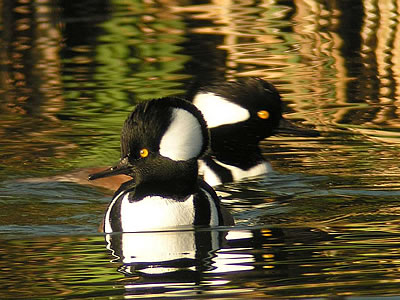
The last time I walked by the water treatment ponds at the Mill Valley Sewer District was about 10 years ago. Now I realize what I've been missing. A recent post on NorthBayBirds alerted me to the presence of 6 pair of Hooded Mergansers on "Gem Pond", which is out back of the MV Sewer treatment tanks. From Camino Alto take a right on Sycamore to go to the MV Middle School/Bay Front Park. The Sewer treatment facilities are near the end on the right. Walk into the facility, make a left into the parking lot, then right on "Coe", which leads you to a berm where you can walk southwest for 75 yards to a pond surrounded by cat-tails. Find an opening and the view is quite a surprise. I saw the 12 Hooded Mergansers, plus a variety of other birds, including a Spotted Sandpiper, Gulls (mostly Ring-billed), about 6 species of ducks (including Ring-billed), Black-crowned Night-heron, etc.
Here's a pair of male Hooded Mergansers (Lophodytes cucullatus) taken today (November 8, 2006). The one in front is telling his younger brother, "Hey, try it again. It's sorta like the 'Kegel' thing that the hens do. You gotta learn to contract the right muscle, and all of a sudden the white patch gets real big and the hens can't take their eyes off you. Watch..."
Technical notes: the photo illustrates some of the limitations of digi-scoping. First, the narrow depth of field one encounters at extreme magnification (40x here). If the subjects are not side-by-side then one will be out of focus. Second, the bright whites, here in full morning sun, just overpower the blacks, so that details in the white are lost ("blown out"). The CCD sensors in digital cameras have a limited dynamic range (4-5 f stops), which hopefully will improve with the next generation of sensors.
2. Hooded Merganiser - equal time for the lady
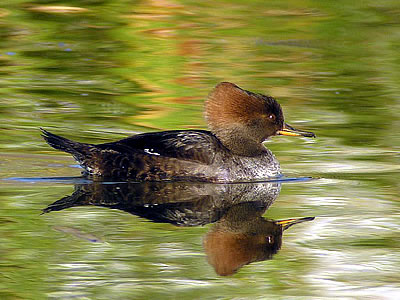
Back to Gem Pond in Mill Valley. The female Hooded Mergansers (Lophodytes cucullatus) are no less striking than the males, and put on quite a show with their crests when not diving for fish and crustaceans (they love crayfish). The lower bill is orange, in contrast to the Red-breasted and Common Merganser hens which have reddish bills. And neither of the others sports such a prodigious crest. You can watch them sleek down the crest just before diving.
Interesting facts to note (from Birds of North America, internet edition): Hooded Mergansers are cavity nesters, using tree cavities just like Wood Ducks and others.The white eggs are almost spherical, measuring about 53 x 44 mm. Mergansers are related to the bucephala (Goldeneyes and Bufflehead), and hybrids have been found, including one locally on Lake Merrit a few years ago. Hooded females have brown eyes, whereas the male's eye is yellow, which helps distinguish sexes in basic plumage birds.
3. Sanderling (Calidris alba)
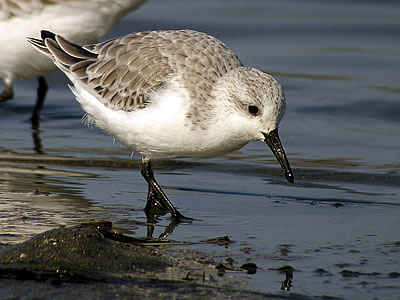
The Sanderling ("little bird of the sand") is probably the most identifiable small shorebird, especially in its basic (non-breeding) plumage. As winter approaches most shorebirds get pretty dull, many showing medium gray upperparts and plain white below. The Sanderling dons a beautiful soft silver cloak, and entertains us with its speedy running along the sandy shores throughout the world. Sanderling is bigger than the other "peeps", and almost as large as the Dunlin. The shiny black bill and feet, plus white forehead, complete the picture. When seen close up, as we were able to do with Rich S at Bodega Bay October 24, the gray feathers reveal a subtle beauty too easily missed when we watch without good optics.
The Sanderling breeds well up in the Arctic regions of the world ("holarctic"), then migrates along almost every coast, and reaches the shores of Argentina and Chile, Africa, etc. Interestingly, Sanderlings have been documented to fly down the west coast, and then in the spring return up along the east coast! Not all of them, but some. Other species of birds are known to have "oval" migration paths, but few with a spread as great as 3000 miles.
4. Northern Shoveler (Anas clypeata)
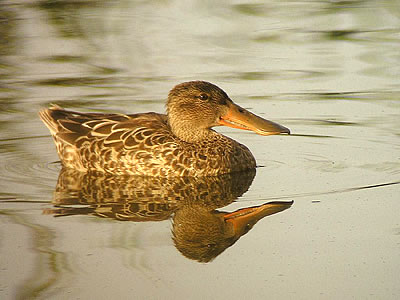
Returned to Gem pond yesterday, only to find the water level down by 2 feet and the pond bereft of Hooded Mergansers and the recently seen female Wood Duck.
But we still have many Pintails, joined by 2 Northern Shovelers (Anas clypeata).
So, if there is a "Northern" Shoveler, there are no doubt some others, n'est pas? Well, the answer lacks precision, as the shovelers are in the genus Anas, which includes some 42 species. Among these are at least 4 species with "shoveler" in the common name. Besides the Northern Shoveler (aka Common Shoveler), we have the Australian Shoveler (A. rhynchotis), the Red Shoveler (A. platalea) from South American, and the Cape Shoveler (A. smithii) from Africa. The spelling "shoveller" is sometimes used.
The Shoveler gets it name from the shape of the bill, which seems well made for digging up the muck on the bottom of a shallow pond. And quite a bill indeed!
5. Northern Pintail - the color of water
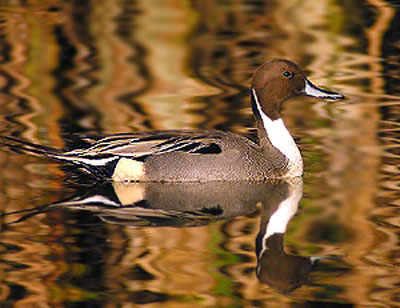
Sometimes the background is prettier than the subject, or at least makes the subject less important in the composition, as here. The colors are reflections of the pond-side foliage, in this case cattails.
Northern Pintail (Anas Acuta), is another of the 40-odd dabbling ducks in the genus Anas. Other pintails include the Yellow-billed Pintail (A. georgica, in So. Amer.), White-cheeked Pintail (A. bahamensis, in the Bahamas), an Eaton's Pintail (A. eatoni, considered by some a ssp. of the A. Acuta). Many ducks are beautiful, but this one has a special elegance about him.
6. Bronze Wigeon
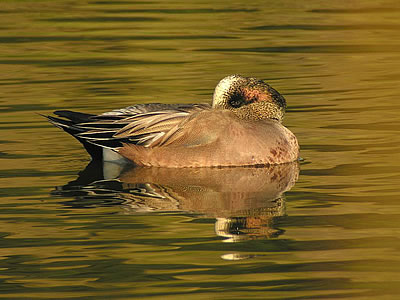
The American Wigeon (Anas americana) is a common dabbler in our area, often seen at the edges of a pond or grazing in nearby vegetation. We know the male by the white stripe on the top of his head (aka "Baldpate") and the bright green "racing stripe" sweeping back from around his eye. But that green streak is really rather black, and the color comes the light waves being broken up and selectively reflected, much like the iridescence of hummingbird or mallard feathers. On occasion when the light is just right we can see a bronze color instead of the usual green, as here in this drake relaxing at Gem Pond, Mill Valley.
There are three wigeons worldwide (the word supposedly comes from the French "vigeon", for a small crane...???) . We are lucky in many areas the Eurasian Wigeon (A. penelope), although there are usually some present on Bolinas Lagoon. For the third we'll have to go to Chile to find the Chiloe Wigeon, aka Southern Wigeon (A. sibilatrix).
7. Butterflies, too!
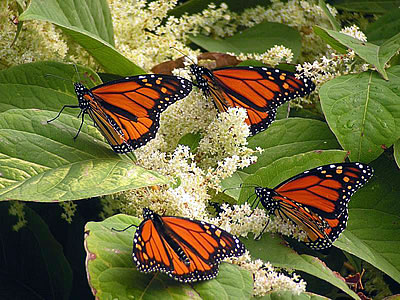
While at Lighthouse Point in East Haven, CT, we saw a bush with orange blossums, or so it appeared. Walking closer we saw hundreds of Monarch butterflies, apparently restocking on energy supplies for the next leg of their journey. The area we found them is also on the flyway for raptors. Digi-scoping is not ideal for butterflies, because of the narrow depth of field, but it does allow them to remain undisturbed by the photographer.
8. Lewis's Woodpecker - Melanerpes lewis
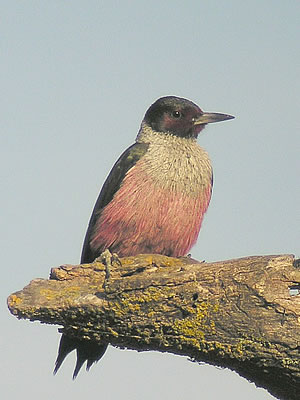
We just returned from an interesting weekend in Stocton, attending the 10th Central Valley Birding Symposium. The highlight for us was a trip to the Salt Springs Valley, where we encountered a variety of raptors, ducks and passerines.
Hiking through a cattle ranch we approached a stand of oaks and quickly noted a group of Lewis's Woodpeckers hawking insects in brief flights from the top of the oaks. It was easier to photograph them on snags, but they never perched for very long. Lewis's Woodpeckers are closely related to Red-headed Woodpecker and Acorn Woodpecker, and in fact compete with them for acorns during the winter where their ranges overlap.
You don't need field marks for this bird, as nothing else looks like it! The rose-pink belly and gray collar are clearly shown on this adult individual (males and females look alike, the male being slightly larger). Less obvious here are the beautiful green sheen on the back and wings, and the maroon coloration of the face, seen only when the light is just right.
9. Yellow-billed Loon - Gavia adamsii
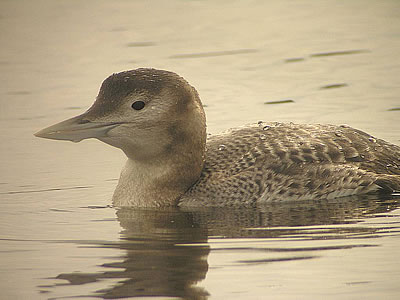
The Yellow-billed Loon seems to have settled in at Pescadero Creek, on the inland side of the bridge. It fishes (rather successfully, too) from the bridge and up the channel to where the creek turns north a bit. See Joe Morlans' website for more detailed information about the bird and the location, along with photos: http://fog.ccsf.edu/~jmorlan/yblo112006.html.
The Yellow-billed Loon is one big bird, weighing in at up to 12 pounds, and definitely larger than his cousin we know so well, the Common Loon. It has a thick neck, heavy based bill, and a nice brownish tinge to the feathers of back and head. I presume this bird is a full adult, just completing molt into basic plumage (but see below!). The bill is pale at the tip, and even appeared a bit yellow in some of my photos. This bird is a diig-scoping challenge, constantly on the move and just waiting for me to pull the trigger and diving a split second before the shutter closes. I got lots of shots of ripples.
10. Juvenile Yellow-billed Loon
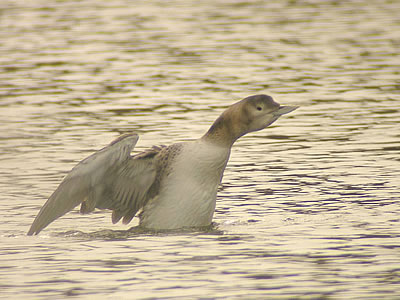
I should have read Joe Morlan's page more carefully, as in fact this it a juvenile bird. It was initially found by Francis Toldi (Audubon Canyon Ranch Board member). As Francis wrote:
"Actually it’s a juvenile (back pattern, overall pale brownish color and the not-fully formed bill are the cues). Francis"
Anyway, here is a somewhat blurry shot showing the underwing, and a bit of action.
11. Last Yellow-billed Loon - I promise
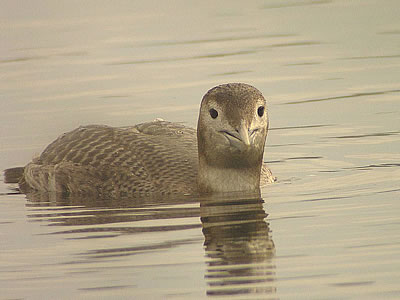
Couldn't resist sending this one last pic of the young Yellow-billed Loon, as it shows a view of the bill that I didn't see in the field. The broad base of the bill isn't surprising, but it is a bit startling to see how much the bill narrows in the vertical axis. At this point the bird was swimming towards me, almost appearing to be curious.
12. American Kestrel - Falvo sparverius
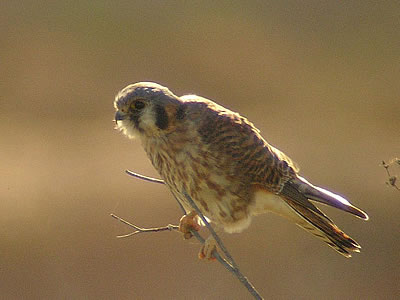
Our smallest falcon, the American Kestrel weighs in at all of 4 oz., yet is a proficient predator of insects and small vertebrates, including rodents and birds. This beauty obliged by perching on a twiggy shrub, in contrast to its usual hunting perch on a wire. If there is no perch handy kestrels are adept at hovering in place as they search below for prey.
This one is probably a female. You see a bit of black barring on her tail, in contrast to the male's plain rufous tail. Male also shows blue wing coverts. The suggestion of blue on the shoulder is a bit confusing, perhaps an artifact of the severe backlighting.Taken at Las Gallinas ponds, Thanksgiving Day. Distance and lighting make for a soft composition, but still better than a closer bird on a wire!
13. Mallard Color
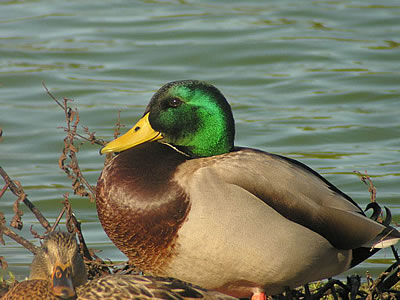
Perhaps we take the Mallard (Anas platyrhynchos) for granted. Yellow bill, green head, red-brown chest, ho-hum. But then we see him in a certain light and the head is violet-purple! What gives?
Well, the feathers of the Mallard's head are not green, of course, but rather black. Sometimes we see the color of feathers because of the pigments present. The type of pigments and their amounts cause a certain color(s) to be reflected. But not so with many hummingbirds, and not so with many of the ducks. We "see" color in their black feathers not because of pigment, but because of the physics of how light is reflected back from certain structures, in a process called "interference". The result of course is the spectacular array of iridescent gold and red and green and purple that dazzle even the most jaded viewer. The same process creates the iridescence in some feathers gives color to some beetles, and to soap bubbles and oil films. I don't know of a simple source that explains it perfectly, but try: http://webexhibits.org/causesofcolor/15F.html.
I apologize that this Mallard male, taken on Thanksgiving at Las Gallinas ponds, looks more like the turkey we ate later than the handsome bird he is.
14. Long-tailed Duck at Stafford Lake
We don't see many Long-tailed Ducks in Central Marin, as the species (Clangula hyemalis) is an Arctic breeder that rarely strays to our region, preferring open seas and more northern climes for wintering. This one has been sighted at Stafford Lake the past 3 days, hanging out with Ruddy and Ring-necked ducks at the North end (make a right as you enter, park near group site #2 and walk toward the lake).
The age and sex of the bird are not obvious. Turns out that the Long-tailed Duck (previously known as Oldsquaw) has a complex molt cycle. Complex? Well, R. S. Palmer, in Handbook of North American Birds, devotes about 8+ pages to a discussion of the molt sequence and plumages. After reading it I had no idea what this bird looks like. Enjoy this distant view, and then please offer your guess as to the age and sex of the bird, as I will do below.
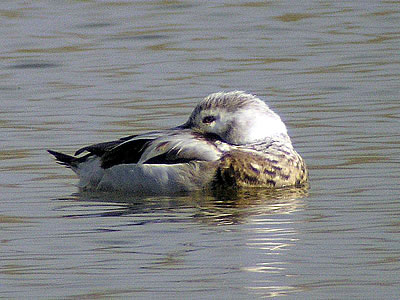
Our bird does not seem to have a long tail. The breast is a medley of black, brown and gray, perhaps in transition. We can't see the bill here, but it was small and fairly uniformly gray, with a hint of pink in the right light. When swimming the black and gray feathers of the back were quite striking. Head has a gray/brown cap.
After looking in the guides, I think this may be a juvenile bird, now molting into basic (winter) plumage. The face and bill look like the juvenile pattern, but the feathering on the back strongly suggests a male in winter plumage. He won't get his long tail until next year.
15. Long-tailed Duck, another view
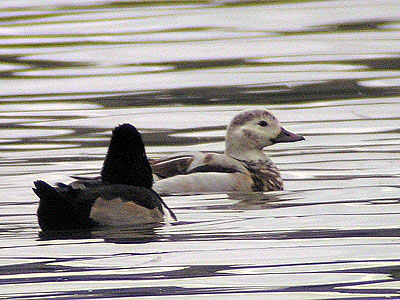
A softer photo, but it shows the face pattern and bill better. Yes, that's a Ring-billed Duck swimming nearby. The long-tailed duck is only 16-17 in long, about the same a the Ring-necked.
16. Bonaparte's Gull
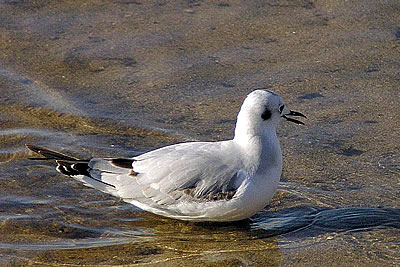
On no, not another gull!!
Trust me, this is not just another gull. Bonaparte's Gull, Larus philadelphia, looks and flies more like a tern than a gull. It doesn't have the forked tail of a tern, but it does have a slender bill that is most un-gullish. See Forster's Tern for comparison.
The winter (basic) plumage seen here is more endearing that the black-hooded (breeding) version we see in the summer. I wonder if this bird is about 1½ years old, as some of the brown feathers look like hold-overs from the 1st summer plumage. Taken during a Rich S. outing at Moss Beach Nov. 30.
TOWHEE.NET: Harry Fuller, 820 NW 19th Street, McMinnville, OR 97128
website@towhee.net